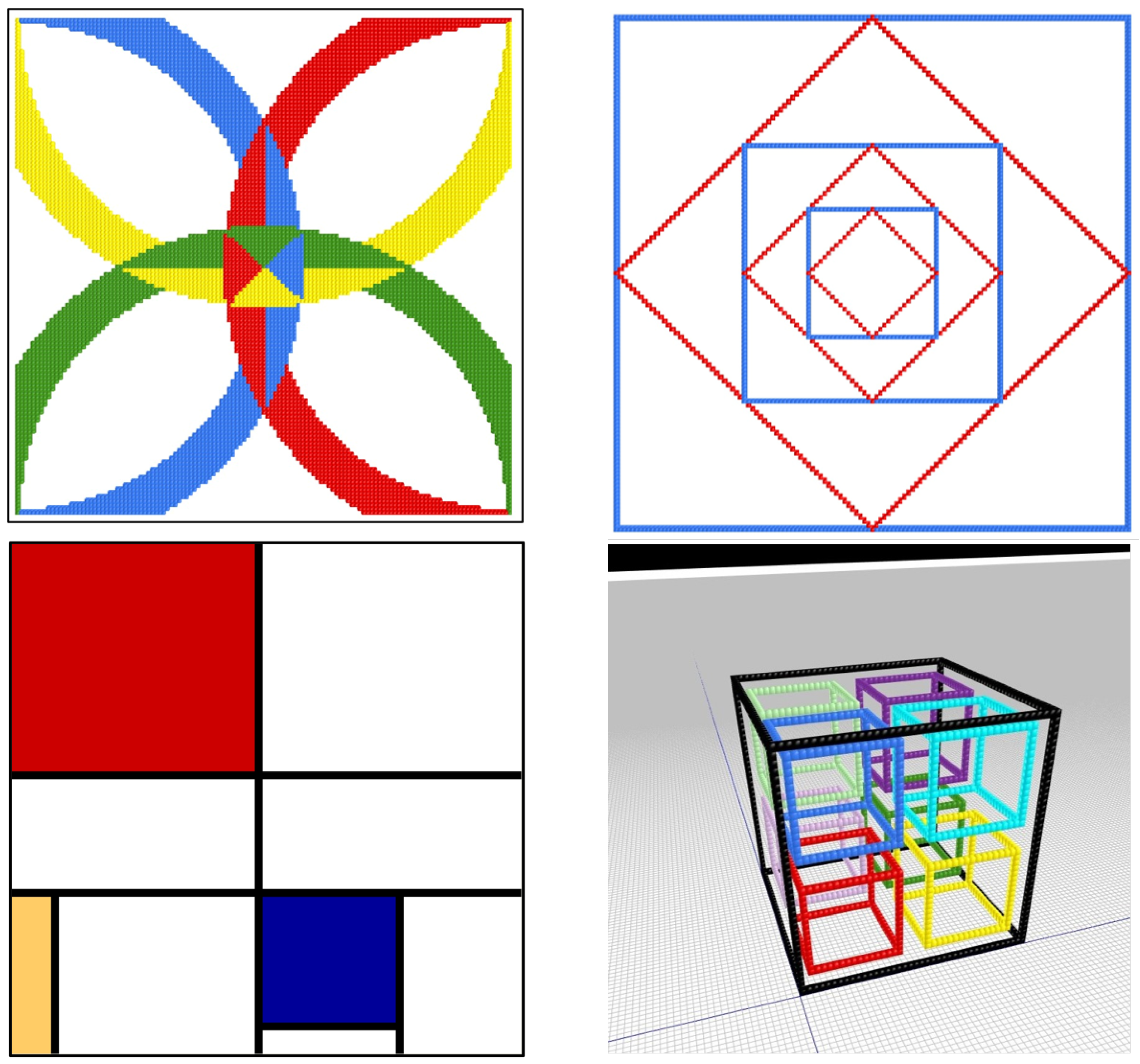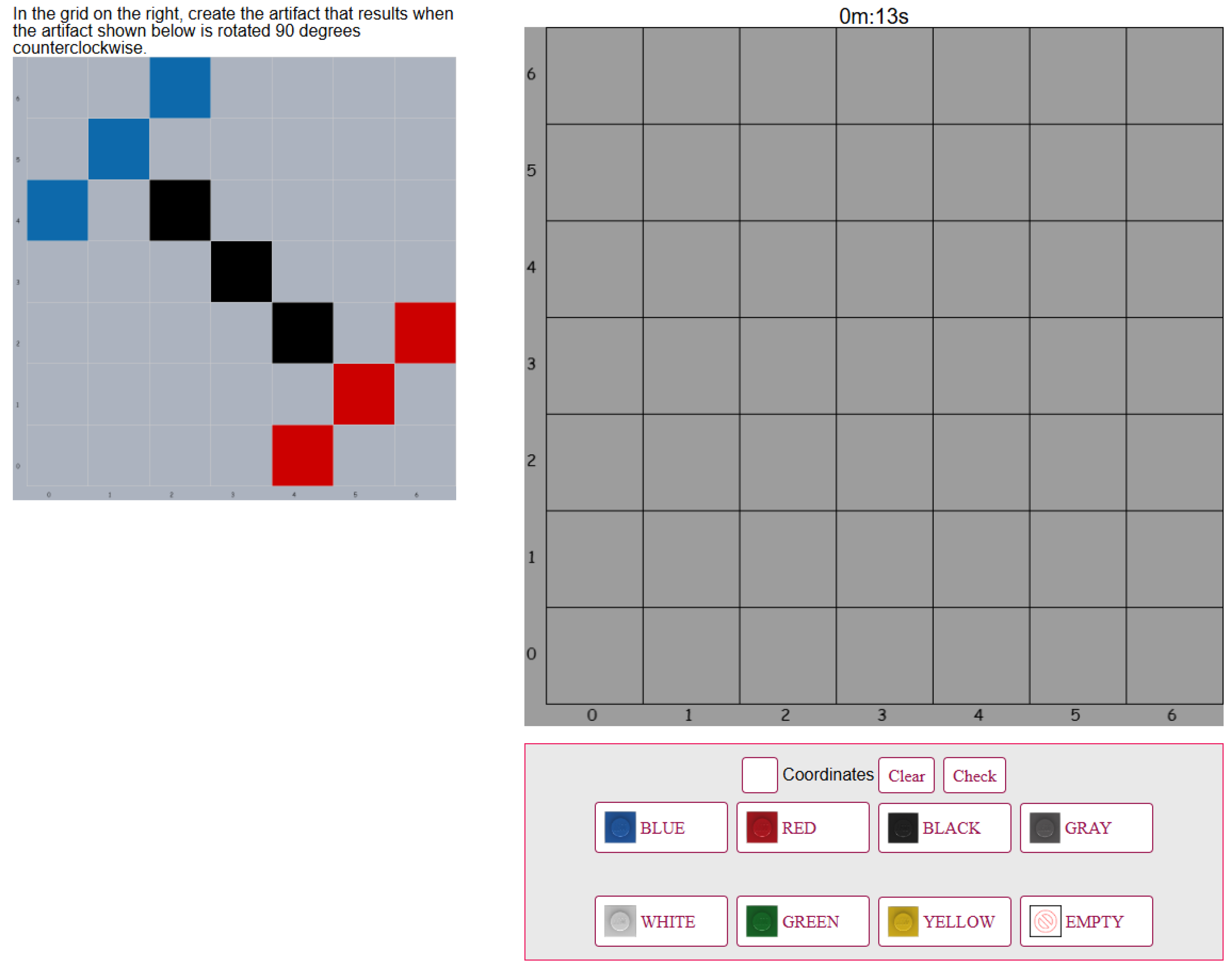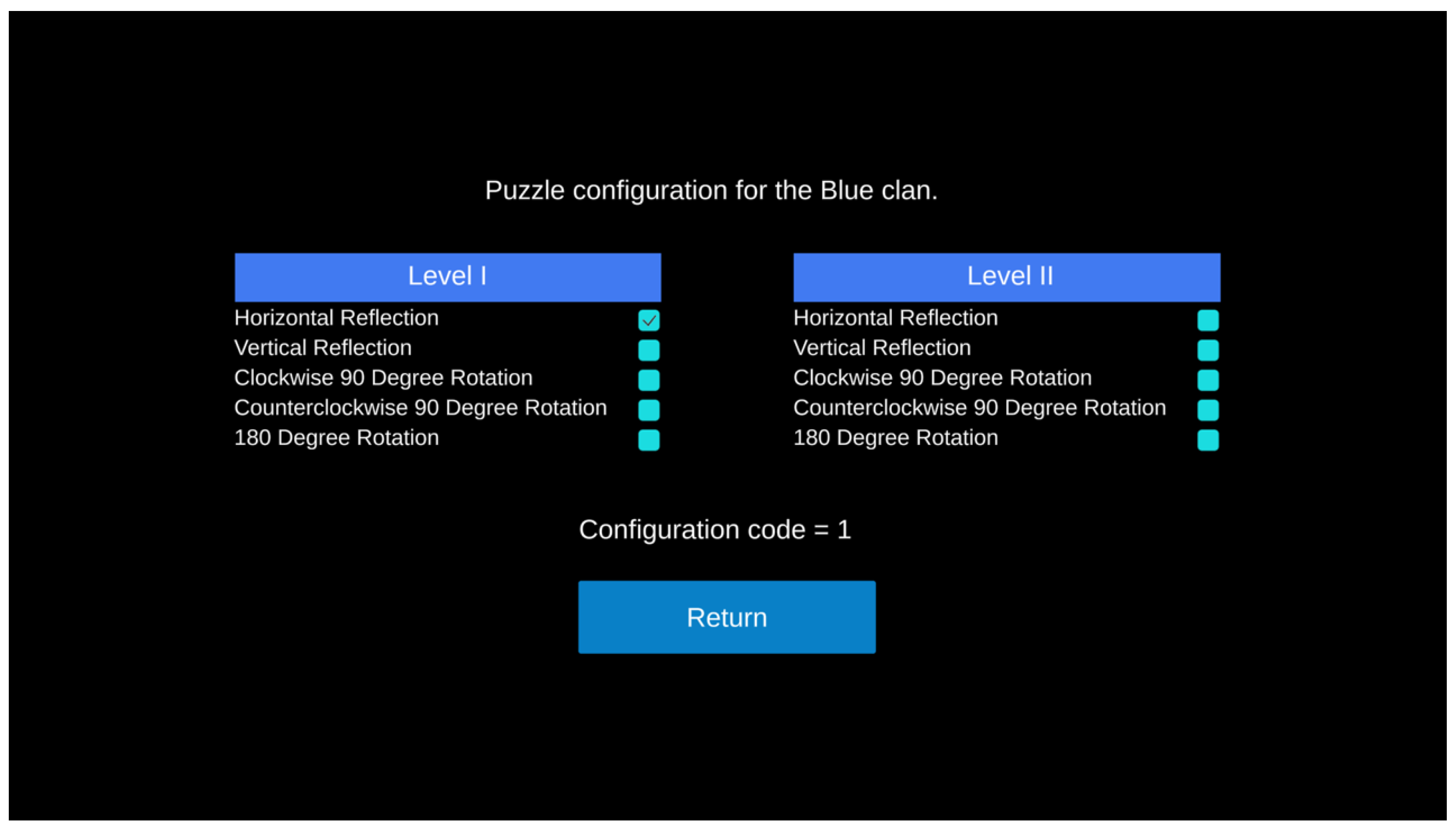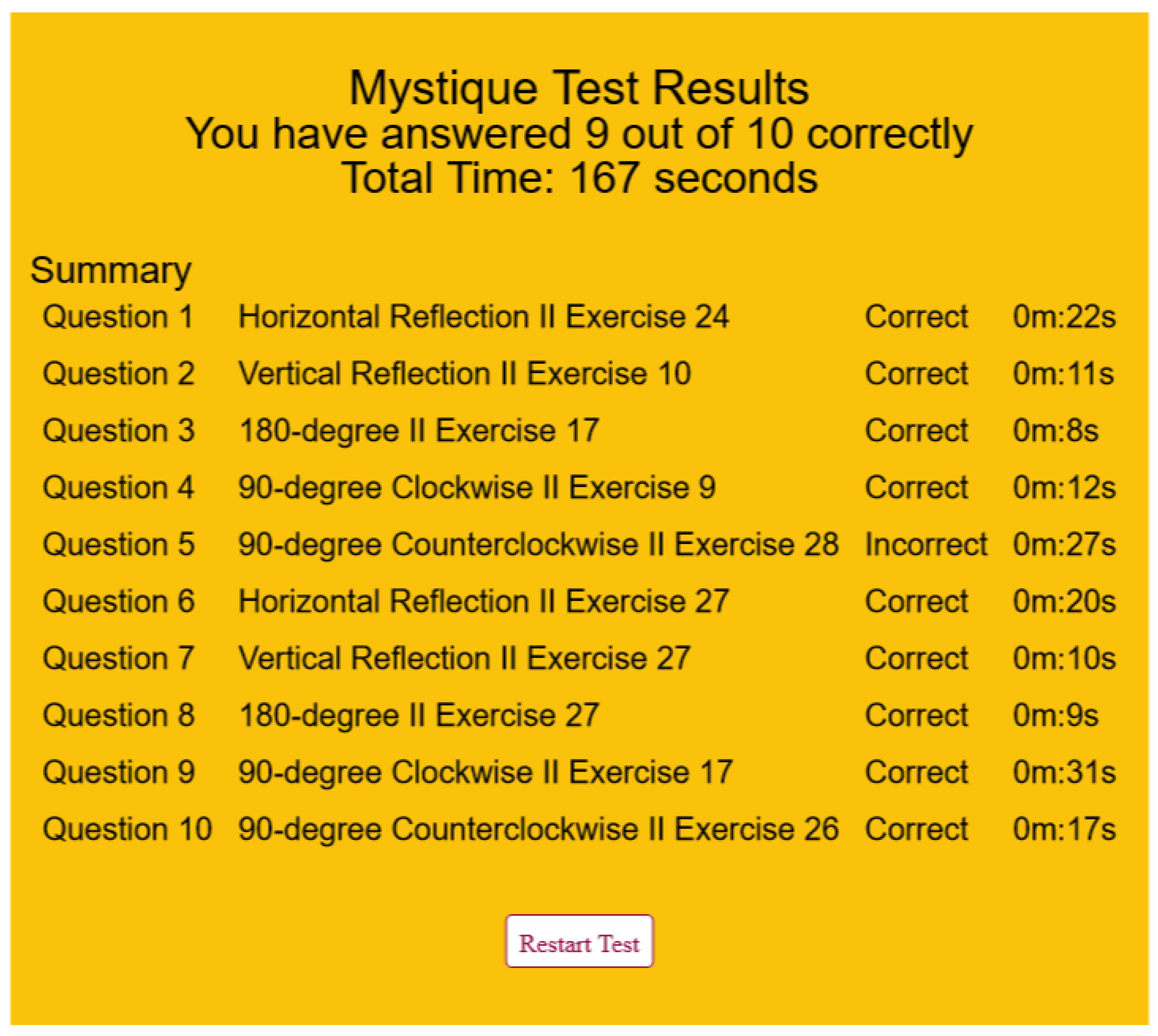Triskelion—In Pursuit of Proficiency Through Immersive Gameplay
Abstract
1. Introduction
- Tasks can be understood after a brief period of instruction;
- Immediate feedback is provided;
- Repeated performance of the same or similar task;
- High accuracy is rapidly attained;
- Emphasis is placed on speed.
Triskelion Matchplay Aligns with These Characteristics
| LS1 | lecture | 2 quizzes | test, Kessel Run | ⋆ test ⋆ |
| LS2 | lecture | 2 quizzes, | Triskelion | ⋆ test ⋆ |
| : | The distributions of response times are the same |
| : | The distributions are different |
2. Materials and Methods
- Group A:
- Introductory content consisting of a lecture and two quizzes.
- A practice test consisting of 10 problems randomly selected from a problem bank. Solving a problem requires creating an artifact that is appropriately flipped or rotated through mouse clicks on a grid. It is important to mention that such tests are generated on an individual basis, meaning each student is provided a unique test of 10 randomly generated problems drawn from the problem bank.
- Playing a 3D game called the Kessel Run [24]. Though the Kessel Run is a video game, it consists primarily of solving symmetry problems. In the Kessel Run, there is no traditional gameplay.
- A final test consisting of 10 problems randomly selected from a problem bank. Solving a problem requires creating an artifact that is appropriately flipped or rotated through mouse clicks on a grid. The problems in this test are drawn from the same problem bank as the practice test. So this can be viewed as taking a test for the second time (i.e., a repetition).
- Group B:
- Introductory content consisting of a lecture and two quizzes.
- Playing a Triskelion match, which is a group-based competition. In contrast to the Kessel Run, Triskelion interleaves elements of standard gameplay with solving symmetry problems. Furthermore, Triskelion provides a clan-based competitive environment, a distinction we feel to be important.
- A final test consisting of 10 problems randomly selected from a problem bank. Solving a problem requires creating an artifact that is appropriately flipped or rotated through mouse clicks on a grid. This final test (of randomly selected problems) is the same test that is given to Group A.
2.1. Introductory Content
2.2. Practice Sequence for Group A: A Practice Test and the Kessel Run
2.3. Practice Sequence for Group B: Triskelion
2.3.1. Triskelion from the Perspective of a Student
2.3.2. Triskelion from the Perspective of a Teacher
- High Score—The high score of each player in their clan. This can provide insight into the level of mastery a student has with the educational material. However, it should be noted that very high scores can only be attained by individuals having exceptional shooter skills (quick and precise mouse movements targeting desired objects).
- Low Score—The low score of each player in their clan. This can provide insight into a student’s improvement over time. For example, a student initially may have a very low score. As they improve, their scores will increase. Thus, in some sense, the difference between a player’s low score and high score approximates a player’s improvement.
- Average Score—The average score of each player in their clan. This can provide insight into whether a student’s progress has stabilized (e.g., reached a plateau where additional gameplay might only yield minor improvement). Consider a situation where there is a large difference between the low score of a student and their high score. In such a situation, if the average score is close to the high score, the student’s learning might have stabilized.
- Games Played—This metric provides insight into the level of engagement of the players in a clan. This metric can be especially useful if students are able to play Triskelion outside of the school day (e.g., at home in the evenings or on weekends).
- Play Time—This metric measures how much time a player spends in-game not engaging with educational content. For example, some students may spend much of their time exploring the Celtic Forest and the ancient Druid ruins.
- Puzzle Time—This metric measures how much time a player spends engaging with educational content. For example, a student who is struggling with the puzzles (i.e., problems) might spend a lot of time engaging with puzzles relative to the time they spend collecting will-o-the-wisps.
2.3.3. Clan Competitions
3. Results
- Horizontal Reflection II;
- Vertical Reflection II;
- 180 Degree Rotation II;
- 90 Degree Clockwise Rotation II;
- 90 Degree Counterclockwise Rotation II.
4. Discussion
Funding
Informed Consent Statement
Data Availability Statement
Conflicts of Interest
References
- Boaler, J.; Chen, L.; Williams, C.; Cordero, M. Seeing as Understanding: The Importance of Visual Mathematics for our Brain and Learning. J. Appl. Comput. Math. 2016, 5, 1–6. [Google Scholar] [CrossRef]
- Newcombe, N.S. Seeing Relationships: Using Spatial Thinking to Teach Science, Mathematics, and Social Studies. Am. Educ. 2013, 37, 26. [Google Scholar]
- National Research Council. Learning to Think Spatially; National Academic Press: Washington, DC, USA, 2006. [Google Scholar]
- Wai, J.; Lubinski, D.; Benbow, C.P. Spatial ability for STEM domains: Aligning over 50 years of cumulative psychological knowledge solidifies its importance. J. Educ. Psychol. 2009, 101, 817–835. [Google Scholar] [CrossRef]
- Maccoby, E.E.; Jacklin, C.N. The Psychology of Sex Differences; Stanford University Press: Palo Alto, CA, USA, 1974. [Google Scholar]
- Caitlin Cole, R.H.P.; Mackenzie, E. A scoping review of video games and learning in secondary classrooms. J. Res. Technol. Educ. 2024, 56, 544–577. [Google Scholar] [CrossRef]
- Abdul, A.; Felicia, P. Gameplay Engagement and Learning in Game-Based Learning: A Systematic Review. Rev. Educ. Res. 2015, 85, 740–779. [Google Scholar] [CrossRef]
- Maloney, J.; Resnick, M.; Rusk, N.; Silverman, B.; Eastmond, E. The Scratch Programming Language and Environment. Trans. Comput. Educ. 2010, 10, 16:1–16:15. [Google Scholar] [CrossRef]
- Schanzer, E.; Fisler, K.; Krishnamurthi, S.; Felleisen, M. Transferring Skills at Solving Word Problems from Computing to Algebra Through Bootstrap. In Proceedings of the 46th ACM Technical Symposium on Computer Science Education, New York, NY, USA, 4–7 March 2015; SIGCSE ’15. pp. 616–621. [Google Scholar] [CrossRef]
- Achten, P. The Soccer-Fun Project. J. Funct. Program. 2011, 21, 1–19. [Google Scholar] [CrossRef]
- Dann, W.; Cooper, S.; Pausch, R. Learning to Program with ALICE, 3rd ed.; Pearson Education: Boston, MA, USA, 2012. [Google Scholar]
- Aljedaani, W.; Ghammam, A.; Mkaouer, M.W.; Kessentini, M. From Boring to Boarding: Transforming Refactoring Education with Game-Based Learning. In Proceedings of the ACM/IEEE 8th International Workshop on Games and Software Engineering, New York, NY, USA, 14 April 2024; GAS ’24. pp. 20–27. [Google Scholar] [CrossRef]
- Forlizzi, J.; McLaren, B.M.; Ganoe, C.H.; McLaren, P.B.; Kihumba, G.; Lister, K. Decimal Point: Designing and Developing an Educational Game to Teach Decimals to Middle School Students. In Proceedings of the 8th European Conference on Games Based Learning (ECGBL 2014), Berlin, Germany, 9–10 October 2014. [Google Scholar]
- Ranosz, J.; Leszczyński, C.; Kumor, S.; Popiel, A.; Głowaczewska, J.; Garwol, P.; Kaczmarek, M.; Maik, M. Advancing STEM Education in Primary Schools with an Integrated System of 3D Games. In Proceedings of the 28th International ACM Conference on 3D Web Technology, New York, NY, USA, 9–11 October 2023. Web3D ’23. [Google Scholar] [CrossRef]
- Guzzetti, B.; Stokrocki, M. Teaching and Learning in a Virtual World. E-Learn. Digit. Media 2013, 10, 242. [Google Scholar] [CrossRef]
- Inman, C.; Wright, V.; Hartman, J. Use of Second Life in K-12 and Higher Education: A Review of Research. J. Interact. Online Learn. 2010, 9, 44–63. [Google Scholar]
- Overby, A.; Jones, B.L. Virtual LEGOs: Incorporating Minecraft into the Art Education Curriculum. Art Educ. 2015, 68, 21–27. [Google Scholar] [CrossRef]
- Mallek, F.; Mazhar, T.; Shah, S.F.A.; Ghadi, Y.Y.; Hamam, H. A review on cultivating effective learning: Synthesizing educational theories and virtual reality for enhanced educational experiences. PeerJ Comput. Sci. 2024, 10, e2000. [Google Scholar] [CrossRef]
- Esper, S.; Foster, S.R.; Griswold, W.G. CodeSpells: Embodying the Metaphor of Wizardry for Programming. In Proceedings of the 18th ACM Conference on Innovation and Technology in Computer Science Education, New York, NY, USA, 1–3 July 2013; ITiCSE ’13. pp. 249–254. [Google Scholar] [CrossRef]
- Esper, S.; Foster, S.R.; Griswold, W.G. On the Nature of Fires and How to Spark Them when You’Re Not There. In Proceedings of the 44th ACM Technical Symposium on Computer Science Education, New York, NY, USA, 6–9 March 2013; SIGCSE ’13. pp. 305–310. [Google Scholar] [CrossRef]
- Ericsson, K.; Krampe, R.; Tesch-Roemer, C. The Role of Deliberate Practice in the Acquisition of Expert Performance. Psychol. Rev. 1993, 100, 363–406. [Google Scholar] [CrossRef]
- Fitts, P.M.P.M.; Posner, M.I. Human Performance; Greenwood Press: Westport, CT, USA, 1979. [Google Scholar]
- Anderson, J.R. Acquisition of cognitive skill. Psychol. Rev. 1982, 89, 369–406. [Google Scholar] [CrossRef]
- Winter, V.; Sherwin, K. The Kessel Run—A Gamification of Visual, Spatial, and Computational Thinking. In Proceedings of the 21st Annual Conference on Information Technology Education, New York, NY, USA, 7–9 October 2020; SIGITE ’20. pp. 426–427. [Google Scholar] [CrossRef]
- Hodent, C. The Gamer’s Brain: How Neuroscience and UX Can Impact Video Game Design; CRC Press: Boca Raton, FL, USA, 2018. [Google Scholar]
- Mohammad, S.; Jan, R.A.; Alsaedi, S.L. Symptoms, Mechanisms, and Treatments of Video Game Addiction. Cureus 2023, 15, e36957. [Google Scholar] [CrossRef] [PubMed]
- Deterding, S.; Dixon, D.; Khaled, R.; Nacke, L. From game design elements to gamefulness: Defining “gamification”. In Proceedings of the 15th International Academic MindTrek Conference: Envisioning Future Media Environments, New York, NY, USA, 28–30 September 2011; MindTrek ’11. pp. 9–15. [Google Scholar] [CrossRef]
- Hamari, J.; Koivisto, J.; Sarsa, H. Does Gamification Work?—A Literature Review of Empirical Studies on Gamification. In Proceedings of the 2014 47th Hawaii International Conference on System Sciences, Waikoloa, HI, USA, 6–9 January 2014; pp. 3025–3034. [Google Scholar] [CrossRef]
- Hamari, J.; Tuunanen, J. Player Types: A Meta-synthesis. Trans. Digit. Games Res. Assoc. 2014, 1, 29–53. [Google Scholar] [CrossRef]












| Accuracy | Response Time | |||||
|---|---|---|---|---|---|---|
| Mean | Std | Median | Mean | Std | Median | |
| Group A | 9.9 | 0.45 | 10.0 | 268.10 | 269.74 | 189.5 |
| Group B | 9.83 | 0.48 | 10.0 | 271.25 | 127.29 | 232.5 |
Disclaimer/Publisher’s Note: The statements, opinions and data contained in all publications are solely those of the individual author(s) and contributor(s) and not of MDPI and/or the editor(s). MDPI and/or the editor(s) disclaim responsibility for any injury to people or property resulting from any ideas, methods, instructions or products referred to in the content. |
© 2025 by the author. Licensee MDPI, Basel, Switzerland. This article is an open access article distributed under the terms and conditions of the Creative Commons Attribution (CC BY) license (https://creativecommons.org/licenses/by/4.0/).
Share and Cite
Winter, V. Triskelion—In Pursuit of Proficiency Through Immersive Gameplay. Information 2025, 16, 28. https://doi.org/10.3390/info16010028
Winter V. Triskelion—In Pursuit of Proficiency Through Immersive Gameplay. Information. 2025; 16(1):28. https://doi.org/10.3390/info16010028
Chicago/Turabian StyleWinter, Victor. 2025. "Triskelion—In Pursuit of Proficiency Through Immersive Gameplay" Information 16, no. 1: 28. https://doi.org/10.3390/info16010028
APA StyleWinter, V. (2025). Triskelion—In Pursuit of Proficiency Through Immersive Gameplay. Information, 16(1), 28. https://doi.org/10.3390/info16010028










